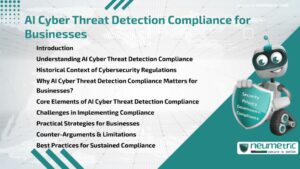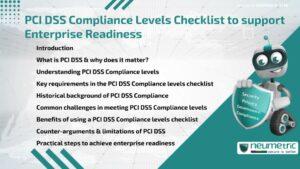Table of Contents
ToggleIntroduction
A PCI DSS Compliance levels checklist is a practical Framework that helps enterprises assess their readiness to secure Cardholder Data & meet global payment security standards. The Payment Card Industry Data Security Standard [PCI DSS] defines security requirements for Organisations that handle payment card transactions. These requirements vary depending on transaction volume & Risk, which is why compliance levels exist. Enterprises that understand & implement a PCI DSS Compliance levels checklist can identify gaps, prepare for audits, avoid fines & build trust with customers.
This article explains what PCI DSS is, why compliance levels matter & how a checklist supports enterprise readiness. It also explores the history of PCI DSS, common challenges, counter-arguments & practical steps that Organisations can take.
What is PCI DSS & why does it matter?
PCI DSS is a set of security standards created to protect payment card data across the entire ecosystem. It applies to merchants, service providers & enterprises of all sizes that process, store or transmit Cardholder Information.
The purpose of PCI DSS is to minimise fraud, reduce data breaches & ensure secure Financial transactions. Without compliance, enterprises Risk penalties from card networks, reputational damage & potential legal consequences. More importantly, non-compliance undermines Customer Trust.
Understanding PCI DSS Compliance levels
Compliance levels are defined based on the number of transactions an organisation processes annually:
- Level 1: Over six (6) million transactions annually. Requires an annual on-site Assessment by a Qualified Security Assessor [QSA].
- Level 2: Between one (1) million & six (6) million transactions. May require a Self-Assessment Questionnaire [SAQ].
- Level 3: Between twenty thousand (20,000) and one (1) million transactions, typically for e-commerce businesses.
- Level 4: Fewer than twenty thousand (20,000) e-commerce transactions or fewer than one (1) million overall transactions annually.
These levels help enterprises understand the scale of security requirements they must meet. The PCI DSS Compliance levels checklist serves as a step-by-step tool to align organizational practices with these standards.
Key requirements in the PCI DSS Compliance levels checklist
The checklist usually includes:
- Building & maintaining secure networks & systems.
- Protecting stored Cardholder Data.
- Encrypting transmission of data across open networks.
- Implementing strong Access Control measures.
- Regularly monitoring & testing networks.
- Maintaining an Information Security Policy.
By using a PCI DSS Compliance levels checklist, enterprises can evaluate how their existing Security Controls align with these Core Principles.
Historical background of PCI DSS Compliance
PCI DSS was introduced in 2004 by major payment brands like Visa, Mastercard & American Express. Before its creation, there was no unified global Standard to protect payment card data. Each company had its own guidelines, which led to inconsistency.
The establishment of PCI DSS created a common baseline for security practices & the introduction of compliance levels allowed businesses to adapt requirements according to their transaction scale. Historical breaches such as the 2005 CardSystems incident highlighted the urgent need for strict adherence.
Common challenges in meeting PCI DSS Compliance levels
Enterprises often face obstacles such as:
- High implementation costs for Level 1 compliance.
- Complex vendor management requirements.
- Limited in-house expertise to interpret PCI DSS controls.
- Resistance from staff who view compliance as burdensome.
Using a PCI DSS Compliance levels checklist can help simplify compliance tasks by breaking them into actionable steps. However, enterprises still need commitment from leadership & ongoing investment.
Benefits of using a PCI DSS Compliance levels checklist
The advantages of a checklist include:
- Clear roadmap for compliance.
- Consistent monitoring & reporting.
- Reduced Likelihood of non-compliance penalties.
- Improved Customer confidence & brand reputation.
- Better preparation for external audits.
Think of the checklist like a flight pre-check list for pilots. It ensures every step is verified before takeoff, reducing the chance of a security failure.
Counter-arguments & limitations of PCI DSS
Some critics argue that PCI DSS Compliance does not guarantee full protection against breaches. For example, Organisations may pass an Assessment but later suffer a data breach due to poor ongoing practices. Others say PCI DSS focuses more on Audit requirements than real-time security improvements.
While these arguments are valid, the PCI DSS Compliance levels checklist still provides a strong foundation. It ensures that Organisations meet a recognized standard, even if they must adopt additional controls for stronger protection.
Practical steps to achieve enterprise readiness
Enterprises can follow these steps:
- Perform a Gap Analysis using a PCI DSS Compliance levels checklist.
- Train staff on PCI DSS requirements & security awareness.
- Implement Security Controls, such as firewalls & encryption.
- Partner with a Qualified Security Assessor for validation.
- Document compliance efforts & update the checklist regularly.
Resources like the National Institute of Standards & Technology (NIST) can also help enterprises align PCI DSS with broader Cybersecurity frameworks.
Takeaways
A PCI DSS Compliance levels checklist provides enterprises with a structured approach to achieving compliance. It highlights gaps, streamlines audits & builds resilience against Risks. While compliance is not the same as security, using the checklist strengthens both enterprise readiness & Customer confidence.
FAQ
What is included in a PCI DSS Compliance levels checklist?
It includes steps for securing networks, protecting Cardholder Data, encrypting transmissions, enforcing Access Controls, monitoring systems & maintaining Policies.
Who must follow PCI DSS Compliance levels?
Any enterprise that processes, stores or transmits payment card data must comply with PCI DSS, regardless of size.
How often should a PCI DSS Compliance levels checklist be updated?
Enterprises should update it annually or whenever there are significant system or process changes.
Does PCI DSS guarantee no data breaches?
No. PCI DSS reduces Risk but does not eliminate the possibility of breaches. Strong security practices beyond compliance are necessary.
What happens if an enterprise fails PCI DSS Compliance?
Non-compliance can lead to fines, higher transaction fees, loss of card processing privileges & reputational harm.
Is Level 1 compliance harder than other levels?
Yes, Level 1 is the most demanding because it requires an on-site Audit & stricter reporting compared to lower levels.
Can Small Businesses use a PCI DSS Compliance levels checklist?
Yes, Small Businesses benefit from a checklist to ensure they meet Level 3 or Level 4 requirements effectively.
Need help for Security, Privacy, Governance & VAPT?
Neumetric provides organisations the necessary help to achieve their Cybersecurity, Compliance, Governance, Privacy, Certifications & Pentesting needs.
Organisations & Businesses, specifically those which provide SaaS & AI Solutions in the Fintech, BFSI & other regulated sectors, usually need a Cybersecurity Partner for meeting & maintaining the ongoing Security & Privacy needs & requirements of their Enterprise Clients & Privacy conscious Customers.
SOC 2, ISO 27001, ISO 42001, NIST, HIPAA, HECVAT, EU GDPR are some of the Frameworks that are served by Fusion – a SaaS, multimodular, multitenant, centralised, automated, Cybersecurity & Compliance Management system.
Neumetric also provides Expert Services for technical security which covers VAPT for Web Applications, APIs, iOS & Android Mobile Apps, Security Testing for AWS & other Cloud Environments & Cloud Infrastructure & other similar scopes.
Reach out to us by Email or filling out the Contact Form…





